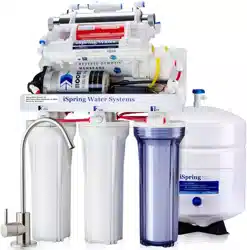Loading ...
Loading ...
Loading ...

Section 2: Knowledge Base and FAQ
What Is Reverse Osmosis?
Reverse osmosis, also known as hyper filtration, is a membrane filtration process that separates
undesirable contaminants from water by using pressure to force the water molecules through a
semi-permeable membrane. This process is called "reverse" osmosis because the pressure forces the
water to flow in the reverse direction (from the concentrated solution to the dilute solution) to the
flow direction (from the dilute to the concentrated) in the process of natural osmosis. Reverse
osmosis is used to purify water and remove salts and other impurities in order to improve the color,
taste, odor and/or properties of your water. RO filtration can remove up to 99% of most
contaminants including arsenic, nitrates, radium, chromium, fluoride, and dissolved solids such as
sodium, calcium, iron, magnesium, copper, etc.
How Effective Is Reverse Osmosis Filtration?
Reverse osmosis filtration is by far the most effective and economic method of water filtration. It
filters water by squeezing water through a semi-permeable membrane, which is rated at 0.0001
micron (equal to 0.00000004 inch). This is the same technology used to make bottled drinking
water. It is also the most used technology for desalinating seawater, making it into drinking water.
What is a TDS meter?
A TDS meter is a handheld Total Dissolved Solids tester. TDS is the total weight of all solids
dissolved in a given volume of water. It is expressed in parts per million (PPM). With a TDS meter,
you can compare the quality of the RO water with your original source water, and also periodically
check the RO water to know when it’s time to change the filters.
What are the specific contaminants that a reverse osmosis system removes?
iSpring Reverse Osmosis filtration systems reject a wide variety of impurities. Here is a partial list:
Item
Rejection Rate
Item
Rejection Rate
Item
Rejection Rate
Aluminum
97-98%
Ferro cyanide
98-99%
Proteins
90+%
Amoebic Cysts
99%
Fluoride
94-96%
Protozoa
99%
Ammonium
85-95%
Giardia
99%
Pyrogen
99+%
Arsenic
94-96%
Hardness
93-97%
Radioactivity
95-98%
Asbestos
99%
Herbicides
97%
Radium
97%
Bacteria
99+%
Hydrocarbons
90+%
Sediment
99%
Barium
90-98%
Insecticides
97%
Selenium
97%
Bicarbonate
95-96%
Iron
98-99%
Silica
85-90%
Boron
50-70%
Lead
96-98%
Silicate
95-97%
Bromide
93-96%
Magnesium
96-98%
Silver
95-97%
Cadmium
96-98%
Manganese
96-98%
Sodium
92-98%
Calcium
96-98%
Mercury
96-98%
Strontium
90-95%
Chloride
94-95%
Nickel
97-99%
Sulfur/Sulfate
97-98%
Chromate
90-98%
Nitrate
93-96%
Sulphite
96-98%
Chromium
96-98%
PCBs
97%
TDS
95-99%
Copper
97-99%
Pesticides
90+%
THMs
90+%
Cryptosporidium
99%
Phosphate
99+%
Trichlorethylene
90+%
Cyanide
90-95%
Polyphosphate
98-99%
Virus
99+%
Detergents
97%
Potassium
92-97%
Zinc
98-99%
Note: You may or may not have these contaminants in your water. The percentage rejection rate is for reference only.
Percentages may vary since water chemistry varies in each water supply.
www.123filter.com | (678) 261-7611 | support@123filter.com Page 18
Loading ...
Loading ...
Loading ...
